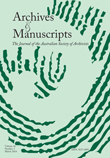Convergence, connectivity, ephemeral and performed: new characteristics of digital photographs
Abstract
The recent convergence of digital cameras into mobile phones with Internet connectivity has provided the opportunity for individuals and organisations to adopt new image-making practices. The widespread use of photo-sharing and social networking platforms for sharing, accessing and storing digital photographs is presenting scholars in the social sciences with new areas of research that address the nature of digital photography. By examining the technological, social and cultural factors involved in contemporary image-making practices, scholars are presenting new concepts regarding the characteristics of digital photographs that impact archival activities aimed at managing and preserving trustworthy digital records. This article identifies and discusses the key concepts emerging from social science research on digital photography that are most relevant to the archival field. Analysis of the findings of these studies suggests that new technologies and social practices are changing how people use digital photographs and their expectations of permanence. Therefore, archivists need to be engaged in interdisciplinary discussions regarding the evolution of photographic practices and emerging characteristics of digital photographs in order to anticipate the management and preservation activities required to protect contemporary visual records for future use.
From 2022 (Volume 50) authors contributing to Archives & Manuscripts agree to publish their work under the terms of the Creative Commons Attribution-NonCommercial-NoDerivatives License), which permits non-commercial re-use, distribution, and reproduction in any medium, provided the original work is properly cited, and is not altered, transformed, or built upon in any way. Authors retain copyright of their work, with first publication rights granted to A&M.




